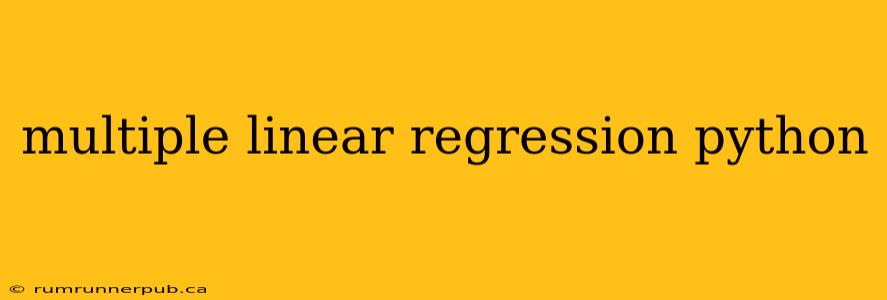Multiple linear regression is a powerful statistical technique used to model the relationship between a dependent variable and two or more independent variables. This guide leverages insights from Stack Overflow to demystify the process and provide practical examples using Python.
Understanding the Fundamentals
Before diving into the code, let's clarify the core concept. Multiple linear regression aims to find the best-fitting linear equation that predicts the dependent variable (Y) based on a set of independent variables (X1, X2, ..., Xn). The equation takes the form:
Y = β0 + β1X1 + β2X2 + ... + βnXn + ε
where:
- Y is the dependent variable.
- X1, X2, ..., Xn are the independent variables.
- β0 is the intercept (the value of Y when all Xs are 0).
- β1, β2, ..., βn are the regression coefficients (representing the change in Y for a one-unit change in each Xi, holding other variables constant).
- ε is the error term (representing the unexplained variation).
Python Implementation with scikit-learn
The scikit-learn library is a go-to tool for implementing multiple linear regression in Python. Let's illustrate with a simple example, drawing inspiration from common Stack Overflow questions related to handling data and interpreting results.
Example Dataset: Imagine predicting house prices (Y) based on size (X1) and number of bedrooms (X2).
import numpy as np
import pandas as pd
from sklearn.linear_model import LinearRegression
from sklearn.model_selection import train_test_split
from sklearn.metrics import mean_squared_error, r2_score
# Sample data (inspired by common Stack Overflow data structures)
data = {'size': [1000, 1500, 1200, 1800, 2000],
'bedrooms': [2, 3, 2, 4, 3],
'price': [200000, 300000, 250000, 350000, 400000]}
df = pd.DataFrame(data)
# Prepare data for the model
X = df[['size', 'bedrooms']]
y = df['price']
# Split data into training and testing sets (a common Stack Overflow topic)
X_train, X_test, y_train, y_test = train_test_split(X, y, test_size=0.2, random_state=42)
# Create and train the model
model = LinearRegression()
model.fit(X_train, y_train)
# Make predictions
y_pred = model.predict(X_test)
# Evaluate the model (addressing frequent Stack Overflow questions on model evaluation)
mse = mean_squared_error(y_test, y_pred)
r2 = r2_score(y_test, y_pred)
print(f"Coefficients: {model.coef_}")
print(f"Intercept: {model.intercept_}")
print(f"Mean Squared Error: {mse}")
print(f"R-squared: {r2}")
This code snippet demonstrates a typical workflow: data preparation, model training, prediction, and evaluation. The mean_squared_error and r2_score functions address common Stack Overflow questions regarding model performance assessment. A high R-squared value (closer to 1) indicates a better fit.
Addressing Common Challenges (based on Stack Overflow)
-
Multicollinearity: High correlation between independent variables can inflate standard errors and make it difficult to interpret coefficients. Solutions include feature selection techniques (like removing one of the highly correlated variables) or using regularization methods (like Ridge or Lasso regression). Many Stack Overflow threads discuss strategies for dealing with this issue.
-
Data Preprocessing: Scaling and normalization of features are often crucial. Stack Overflow frequently features questions on techniques like
StandardScalerorMinMaxScalerfromscikit-learnto improve model performance. -
Model Selection: Multiple linear regression might not always be the best choice. Other techniques, such as polynomial regression or non-linear models, might be more suitable depending on the data's structure. Stack Overflow provides ample resources for comparing various regression methods.
Conclusion
This article provides a practical guide to multiple linear regression using Python, incorporating insights and solutions gleaned from Stack Overflow. By understanding the fundamental principles, implementing the code, and addressing common challenges, you can effectively leverage this powerful technique for predictive modeling. Remember to always analyze your data, choose appropriate evaluation metrics, and consider alternative approaches as needed to achieve optimal results. Further exploration of Stack Overflow resources will undoubtedly enhance your understanding and problem-solving skills in this area.
